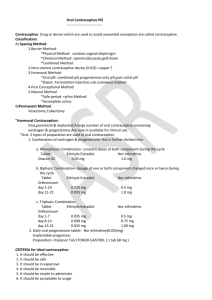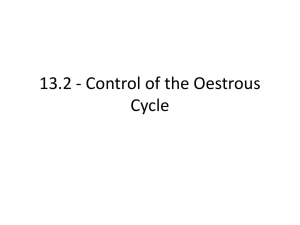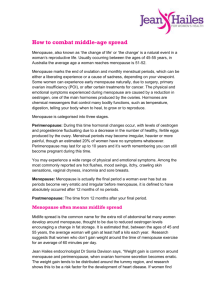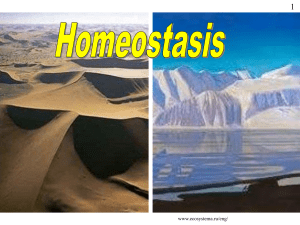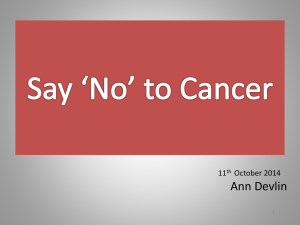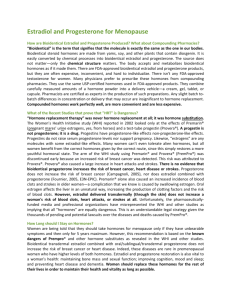Menopause power point – text from slides
advertisement
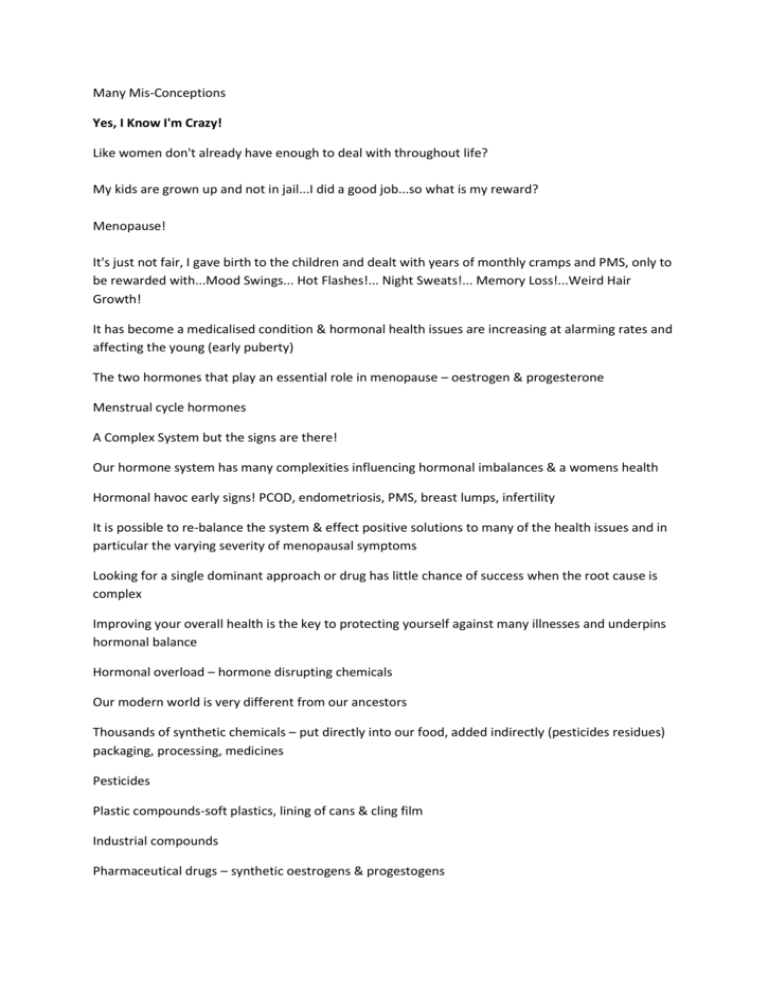
Many Mis-Conceptions Yes, I Know I'm Crazy! Like women don't already have enough to deal with throughout life? My kids are grown up and not in jail...I did a good job...so what is my reward? Menopause! It's just not fair, I gave birth to the children and dealt with years of monthly cramps and PMS, only to be rewarded with...Mood Swings... Hot Flashes!... Night Sweats!... Memory Loss!...Weird Hair Growth! It has become a medicalised condition & hormonal health issues are increasing at alarming rates and affecting the young (early puberty) The two hormones that play an essential role in menopause – oestrogen & progesterone Menstrual cycle hormones A Complex System but the signs are there! Our hormone system has many complexities influencing hormonal imbalances & a womens health Hormonal havoc early signs! PCOD, endometriosis, PMS, breast lumps, infertility It is possible to re-balance the system & effect positive solutions to many of the health issues and in particular the varying severity of menopausal symptoms Looking for a single dominant approach or drug has little chance of success when the root cause is complex Improving your overall health is the key to protecting yourself against many illnesses and underpins hormonal balance Hormonal overload – hormone disrupting chemicals Our modern world is very different from our ancestors Thousands of synthetic chemicals – put directly into our food, added indirectly (pesticides residues) packaging, processing, medicines Pesticides Plastic compounds-soft plastics, lining of cans & cling film Industrial compounds Pharmaceutical drugs – synthetic oestrogens & progestogens Oestrogens Effects * Indicates that these effects are caused by oestrogen dominance, or an imbalance of oestrogen caused by too little progesterone. ** Indicates that these effects are caused by an excess of progesterone. *** Indicates that these effects are caused by a deficiency of oestrogen Creates proliferative endometrium Breast cell stimulation (fibrocystic breasts*) Increased body fat and weight gain* Salt and fluid retention Depression, anxiety, and headaches* Cyclical migraines* Poor sleep patterns* Interferes with thyroid hormone function* Impairs blood sugar control* Increased risk of blood clots* Little or no libido effect* Reduced oxygen levels in all cells* Loss of zinc and retention of copper* Causes endometrial cancer* Increased risk of breast cancer* Increased risk of prostate cancer* Restrains bone loss Reduces vascular tone (dilates blood vessels) Triggers autoimmune diseases* Creates progesterone receptors Relieves hot flashes*** Prevents vaginal dryness & mucosal atrophy*** Increases risk of gall bladder disease* Improves memory*** Improves sleep disorders*** Improves health of urinary tract*** Relieves night sweats*** Progesterone Effects Maintains secretary endometrium Protects against breast fibrocysts Helps use fat for energy Natural diuretic Natural anti-depressant & calms anxiety Prevents cyclical migraines Promotes normal sleep patterns Facilitates thyroid hormone function Helps normalize blood sugar levels Normalizes blood clotting Helps restores normal libido Normalizes zinc and copper levels Restores proper cell oxygen levels Prevents endometrial cancer Helps prevent breast cancer1 Stimulates new bone formation Improves vascular tone Prevents autoimmune diseases Increases sensitivity of oestrogen receptors Necessary for survival of embryo Precursor of corticosteroid biosynthesis Prevents coronary artery spasm & atherosclerotic plaque. Sleepiness, depression** Digestive problems** Progesterone deficient? Hormones need to be in balance to work well Difficult to achieve in modern times Competition from synthetic hormones (mainly oestrogens / xenoestrogens) leads to oestrogen dominance When Progesterone decreases eg; annovulatory cycles / menopause Body adapts by making more oestrogen (aromatisation) Cholesterol converts to pregnenolone which makes progesterone or DHEA which can further convert to testosterone or oestrogen If oestrogen is made this way is increased production of testosterone (esp if receptor sites for oestrogen are filled with synthetic or xenoestrogens) Hair loss on scalp, unwanted hair on legs & face & obesity At menopause production of oestrogen fall by only ½ to 1/3 of pre-menopausal levels. Progesterone decreases to 120th of baseline levels yet it is oestrogen that is more widely prescribed to tx menoapusal symptoms and protect against oesteoporosis & CVD What is Menopause & why does it occur? Peri-menopause Peri-menopause- can start years before your period stops Symptoms of perimenopause can begin as early as age 30 or as late as age 50. For some women the symptoms are mild and only last from 2-6 years, for other women the symptoms are severe and can last as long as 12 years. Peri menopause is considered to be over once a woman has gone 12 months without menstruating. Severe perimenopause symptoms can include, breast tenderness, urinary problems, severe premenstrual problems, insomnia, sleep disorders, depression, menstrual issues, fatigue and severe mood swings. Menopause process usually takes 10 years to complete 45-55 years At menopause lower levels of oestrogen are made, no longer needed to prepare womb for pregnancy As oestrogen falls menstruation is lighter & often irregular until it stops altogether Menopause should occur gradually allowing body to adapt to its new condition with ease With cessation of ovulation, progesterone is no longer produced Body compensates to release FSH & LH Menopause is often confirmed by a rise in the levels of these 2 hormones Break Signs, Symptoms & Risk Factors Hot Flashing (HF) (HF) Minor annoyance to intense unpleasant sensation Hypothalamus regulates temperature, moderated by oestrogen Body dissipates heat by vasodilatation (opening up blood vessels) causing sensation of a HF external stiumli – anxiety, stress, ambient high temperature, coffee, alcohol Body composition, less fat mass increases intensity Adrenaline often follows a HF Weight Gain Fat cells produce oestrogen – body works harder to convert calories to fat to increase oestrogen levels Water weight & bloating from decreased progesterone Decrease in testosterone – fewer calories converted to lean muscle mass therefore lowering metabolism Fat conversion increases insulin resistance Underactive thyroid Weight Gain Management Seriously....Reduce Your Stress! Adrenaline & cortisol Competition for progesterone binding sites Calcium released – elevates heart rate Blood sugar - hyperglycaemia Elevated Insulin Increased fat storage abdominally Insulin resistance, hardening of the arteries, arthritis, osteoporosis, CVD Memory loss ‘Brain Freeze’ Trouble remembering names Fuzzy thinking Forgetfulness Difficult concentrating It has now been determined that declining oestrogen is not the cause but the ‘symptoms’ of menopause are; stress, tension, sleeplessness, depression! Poor sleep Fluctuating hormones rather than depletion cause sleeplessness Oestrogen enhances 2 brain neurotransmitters (GABA & Serotonin) – sleeping pills and prozac both effect these neurotransmitters Heat (HF) – adrenaline Anxiety & Depression Neurotransmitter serotonin, boosts mood and reduces anxiety Loss of libido Psychological, physical, relational, hormonal? Oestrogen, increases sensation, lubrication & health of vaginal tissue (vaginitis) Reduced testosterone Irregular periods, fatigue, vaginal dryness Headaches Oestrogen excess – suppresses enzyme which breaks down ‘amines (one amino acid)’ eg; serotonin & adrenaline Amines are potent constrictors of blood vessels – causing headache & migraine Avoid amine foods eg; cheese, wine, chocolate, dairy, soy sauce Osteoporosis (the ‘silent’ disorder) is not a calcium deficiency disorder It is a disorder where calcium is lost from the bone When oestrogen declines – menopausal bone loss occurs & can be accelerated Progesterone is the bone builder Cortisol chronically elevated contributes to bone loss Thyroid hormone & testosterone also affect bone loss Staying Hormonally Healthy Adrenals, Thyroid, Gut A healthy digestive tract essential for hormonal balance Hormones are made from the food that you eat (protein!) Gut produces many hormones that help you digest & absorb essential nutrients required to make other hormones Straining digestive system reduces body’s ability to cleanse itself of toxins Food allergies/intollerances Fibre – increases SHBG & FOS Adrenals, Thyroid, Gut Oestrogen dominance affects thyroid function Food allergies/intollerances Thyroid hormones are made from: Amino acid tyrosine, converted to thyroxine then into T3 & T4 This is dependent on enzymes requiring zinc (at least 10mg daily) & selenium (at least 35 mcg daily) Iodine (eg; kelp) Minimise stress & stimulants (caffeine & nicotine) Chromium as stress hormones compete with thyroxine Adrenals, thyroid, Gut In menopause produce oestrogen & progesterone to correct imbalance Vitamin C B5 (pantothenic acid) – converts choline (found is fish & eggs) into neurotransmitter acetylcholine = sex drive & vaginal lubrication Magnesium chromium Bio-identical hormone replacement Derived from natural sources – soya or wild yam (phytoestrogens) Converted in lab to exactly the same structure as the body would have made (natural or bioidentical) Delivery method is important –pill (converted in the liver), patch, vaginal gels, creams (absorbed into the blood stream) Liver involvement can increase proteins assoicated with CVD – CRP, clotting factors HRT – synthetic hormones Ratios of oestriol (90% weakest form & most abundant pre-menopause), oestradiol (7% most potent), oestrone (3%) – in HRT proportions are nothing as above Oestrone most abundant, then oestradiol then horse oestrogens Oestradiol acts more like testosterone Soy based gels can assist with problems of vaginal dryness & sex drive by helping to top us testosterone Patent’s & $$$$$ Natural substances cannot be patented Natural substances slightly changed can be patented Not profitable for a pharmaceutical company to produce eg; progestrone as cannot be patented Side effects are produced from alterations to natural substances eg; herbal medicine Medical Testing Fasting Homocysteine Hormonal assay (profile) Fasting lipids (cholesterol) HS CRP (inflammation CVD) Thyroid function Liver function Balance your hormones naturally with diet & lifestyle Basic Principles- second rate fuel gives a second rate performance! Reduce the amount of diary foods & red meat. This reduces saturated fat intake & keeps oestrogen lower Eat foods not exposed to pesticide residues (peel or organic fruit & vegetables) Include regular intake of white fish for essential fatty acids Cook from fresh and choose simple, nutrient rich foods Cook with minimal amts of butter, coconut oil or olive oil Eat a variety of vegetables, nuts, seeds, berries, fresh fruit, pulses, root vegetables Learn how to use protein rich vegetarian sources eg; quinoa, beans & lentils Fibre! 20-30 grams daily for hormonal balance Avoid alcohol, smoking refined carbohydrates, sugar and confectionery Limit caffeine and avoid after 3pm if possible Expand your range of foods & cooking methods Minimise intake of burned, fried or BBQ foods Minimise or avoid where possible intake of hydrogenated fats 1-2 litres of fluid daily Include herbs & spices to foods Salt minimally Eat low – mod GI foods Adequate protein (1 gram per kg body weight) Sample Menu-Bfast Glass water with lemon or lime on rising Bfast-1-2 eggs (poached or scrambled) 1 slice rye or wholemeal toast/nut butter Portion fresh fruit Or.. Protein shake on the run (power packed!) Or.. Low GI cereal & low fat yoghurt, bircher muesli xtra flaxseeds Sample Menu – snacks x 2 Handful nuts with pc of fruit or pc raw vegetable Mug green tea, herbal tea or coffee alternative 25g cheese Low fat pottle yoghurt 200ml smoothie 2 rice crackers with nut butter Nut/seed bar or protein ball Sample menu - lunch Portion of lean meat & Salad or vegetables Cottage cheese Tuna Salad / wrap Small portion ¼ c of rice (basmati or brown) Mixed legume soup Sample menu - dinner Palm of hand lean meat portion ¼ plate 2-3 cups low GI vegetables ½ plate Starch or higher GI portion ¼ plate eg; rice, pasta, root vegetables Stirfry lean meat / tofu + vegetables 20ml oil daily on salad or vegetables 1 standard glass (10g alcohol) red wine Sample menu - evening Hot or cold cherry juice Green tea 2 squares high cacao chocolate Low fat yoghurt & protein powder Fruit portion with nut cream (eg; cashew cream) Specific Supplementation Vitamins, Minerals & EFA’s Zinc, B6, B12 & folic acid, magnesium – enzymes / hormone production Essential fatty acids – fish oils, black currant oil, evening primrose oil – down regulates inflammation & looks after cellular health Vitamin E – reduces intensity of HF Digestive enzymes & gut support – digestive health fundamental for hormonal balance Chromium – blood sugar balancing Multi vitamin/mineral for women over 40 – nutritional gaps & bone health Herbal medicine Dong quai, Black cohosh, Wild yam, Fennel – all have progesterone enhancing effects Black cohosh – reduces HF, sweating, insomnia, anxiety Dong quai – reduces HF St Johns wort – SSRI inhibitor for mood, anxiety & mild depression Vitex agnus castus – elevates progesterone Ginseng & liquorice – powerful adaptogens Liquorice – phytoestrogen & adrenal support Phytoestrogens – beans, lentils, soy, fennel, linseeds, peas, hops, red clover Break Exercise Prescription Significant Benefits Weight management Mood Concentration Sleep memory Weight bearing (bones & muscles) & resistance exercise (body weight or objects to create resistance) – two main forms of exercise that boost health of bones – prevention is vital Resistance 2 x per week Cardiovascular 2 x per week Stretching / yoga / pilates 1 x per week Summary Eat good sources of phytoestrogens every day incl; beans, soy products such as miso, tempeh, tamari. Up intake of anti-aging antioxidants by eating lots of bright coloured fruits & vegetables Balance blood sugar by eating low GL diet and supplementing with chromium 200mcg in the morning Take a high strength multivitamin with additional vitamin C (1-2 grams) containing also berry extracts & EFA – omega 3 & 6 Check homocysteine levels Consider natural or bio-identical hormones Try herbs; Black cohosh, Dong quai, St johns wort if you are prone to depression / anxiety Get fit with frequent weight bearing & resistant exercise Learn ‘belly breathing’, learn yoga or pilates Your hormonal profile is unique menopause is not a disease that needs to be cured-it is a natural life stage, and every woman ought to choose her own mix of options for coping with symptoms. Its not all about us!!!
